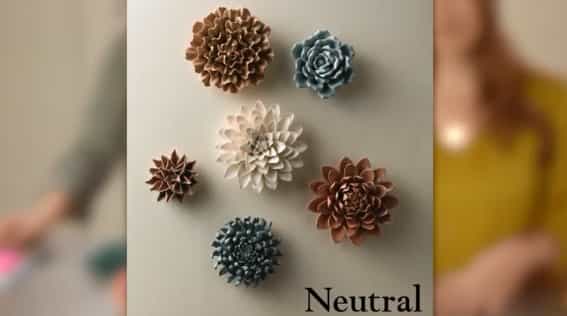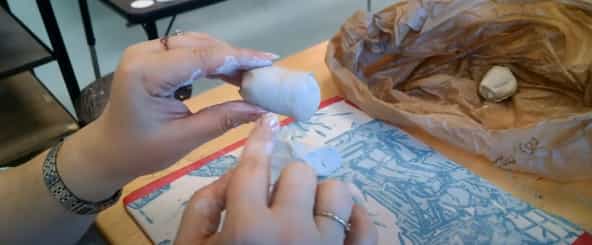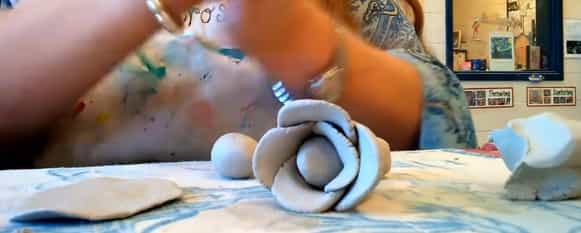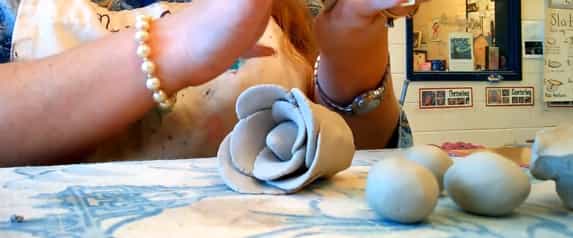
Ceramic flowers are beautiful tools that light up our homes and offices. To beautify our homes and offices, use ceramic flowers. Making ceramic flowers doesn’t require a lot of effort or time. One can make them by following some easy steps. Follow our guide to learn how to make ceramic flowers at home by yourself.
A ceramic flower is made up of different layers that make a beautiful view and more colorful. Using a knife and slab, prepare a flower. After creating the best flower, it needs to be hardened in a kiln or oven. Firing the flower gives it a beautiful smooth shape and also gives it strength.
What is the procedure to make ceramic flowers?
We will discuss step by step method to make ceramic flowers. Try making ceramic flowers at home instead of hiring a professional person. By the end of the article, you will be able to create your ceramic flower.
How to make a ceramic rose flower
We’ll follow the steps listed below.
- Kneading the mud:
- Placing on a rolling wheel
- Making the shape
- Narrowing the opening
- Hardening the mud
- Creating the neck
- Making the mouthpiece
- Shaping of bowl
- Creating a tunnel
1) Giving the shape

The first step is giving shape to clay. Clays turn into grape-sized pieces with the help of hands. Place the clay onto a wide wooden or plastic play.
Start molding the clay on a large area. Take out small pieces from clay and start making shapes with those pieces. Use fingers to make grape shapes from clay. Create a tapered point in clay by pinching it with your fingers.
The piece of clay will serve as the center of our ceramic flower. Making bulk of clay-like this will require a lot of separate places, so set it aside. Don’t worry about purchasing the clay. You can order it online. Read more, how to make a ceramic bong?
2) Pinching the ball
2. Pinch the ball from the upper end and flatten it. It will serve as the petal of the flower. Use fingers to pinch the small section from a large piece of clay. Circling the ball requires the rolling of clay.
Try making these small balls a few millimeters thick. If you tried flattening the ceramic clay in the center of your palm, it would naturally give a curved look. You may like, repair hairline cracks in the ceramic floor tile.
3) Folding the petal

3. Next step is folding the petal. Perform this step with care. Try folding the petal of the flower around the tip of the ceramic teardrop.
Hold all the apparatus, including teardrop and petal, into one hand. While holding the teardrop in one hand, fold the petal using your opposite hand around the edge of the curve. Press from sides of folded petals. It is necessary to give it a hard look and press it well. Popular content, how to print on ceramic mugs at home?
The petal we just installed will cover two-thirds or one-third of the base of a teardrop.
4) Installing a second petal

4. Install a second petal on the first petal. Be sure that you are installing a new petal opposite of the previous petal. Both petals will overlap, and just don’t worry about that. Repeat the same process as you did with petal before. Be sure that you leave some gap between the petals and the central tip.
You will come to notice that both petals are making a “C” shape around the counter piece overlap one on another. Also read, how to make ceramic decals?
5) Forming final petal layer
Take another flattened piece and place it on ceramic rose to form a third layer. Take the third piece and wrap it around the rose. Pinch slowly from the top, and it will a perfect shape.
It looks more expensive and colorful. Pinching from upward makes it more realistic. Press the clay from all sides of the ceramic rose; it will ensure that clay is attached from all sides of the rose.
The process is repeated in same for another piece of clay and so on. Desire is to make the petals of a flower to keep installing the layers one after one. Remember to bend the newly installed clay from the edges and keep folding it back. Avoid using a rush of force instead tries to keep pushing it slowly and gently?
Fold the petals in such a way that it looks more likes a leaf. One precaution you need to keep in mind is that the tip of the counter piece should still be visible, and the inner layers of the rose should be visible. Check here, how to make ceramic beads?
6) Overlaying 4 new layers
Overlap new 4 layers of clay around the rose to make it more beautiful. As we proceed towards the end of the process, it becomes difficult to install the layers. So, it would be best if you were very careful in this process. Using an excess of water in layers disturbs the layout. It becomes challenging to attach new petals to the rose.
7) Precaution
The clay at this stage is a little dry, don’t mix water at this stage as mixing water will make it gel-like, and water doesn’t absorb properly. Hence, before starting the process, make two clays. Make clay, one with a lower water concentration and one with a higher water concentration.
Use the low water content clay at the start of the process. Till you reach the 7th or 8th layer, you need the other clay, which now has good water content. Only here you need little attention; otherwise, all the steps are very easy to perform. Just know about the basic knowledge of making ceramic roses. Related context, how to make a plaster mold for ceramics?
8) Baking the flower
We have almost completed our process. All the procedure necessary to make clay is completed now. The finishing step includes the baking of flowers in a kiln or an oven. Putting the flower in a kiln will permanently harden it. The temperature of the kiln is directly dependant on the ceramic clay. The quality of clay determines the baking temperature.
For example, if you are dealing with low clay, you need to set the temperature to 2079 Fahrenheit, or it is just equal to 1137 degrees. This temperature range is for low-fire clay only, not for all clays. In the case of porcelain clays, need to set the temperature around 2237 Fahrenheit, or it is equivalent to 1222 degrees.
Don’t ever remove the rose from the kiln before completion of the kiln cycle. Set the timer on the oven, and it will beep to inform you. If you lack the proper kiln, contact the local assistance center or community center to help you.
Please don’t take the rose out from the kiln while it is still hot. First, turn the kiln or oven off and let it cool. Then take out your rose.
Best way to make ceramic flowers
Creating ceramic flowers can be a beautiful and artistic endeavor. Here’s a step-by-step guide on how to make ceramic flowers:
Materials and Tools You’ll Need:
- Clay: Choose a suitable ceramic clay for your project. Porcelain and stoneware clays are popular choices for ceramic flowers.
- Pottery Wheel or Hand-Building Tools: Depending on your preference and experience, you can use a pottery wheel or hand-building tools like sculpting tools, rolling pins, and clay cutters.
- Kiln: Access to a kiln for firing your ceramic flowers is essential to harden the clay.
- Glazes: Ceramic glazes come in various colors and finishes. Select the glazes you want to use for your flowers.
- Brushes: Fine brushes are necessary for applying glazes to your ceramic pieces.
- Water and Sponges: These are used for smoothing the clay and cleaning your tools.
Steps to Make Ceramic Flowers:
Prepare Your Workspace:
Ensure your work area is clean and organized. Have all your materials and tools ready.
Choose a Design:
Decide on the type of flower you want to create. Research and gather references for the flower’s shape and details.
Prepare the Clay:
Wedge and prepare your clay to remove air bubbles and make it more pliable. The clay should be soft and easy to work with.
Form the Petals:
Depending on the flower you’re making, start forming the petals using either the pottery wheel or hand-building techniques. For hand-building, roll out a slab of clay and cut out petal shapes. Sculpt and shape each petal as needed, paying attention to the flower’s natural curves and details.
Assemble the Flower:
Layer and attach the petals together using slip (a mixture of clay and water) or scoring (making small scratches on the surfaces to be joined) to create the flower’s shape. Keep the flower’s anatomy in mind, ensuring that the center and petals are proportionate.
Add Details:
Use additional clay pieces to create the flower’s center, stamen, and any other intricate details. Sculpt and attach them to the flower.
Let It Dry:
Allow your ceramic flower to dry slowly and evenly. This process can take several days or more, depending on the size and thickness of your piece. Cover it with plastic to prevent drying too quickly and cracking.
Bisque Firing:
Once your flower is completely dry, it’s time for the first firing, known as the bisque firing. This firing will harden the clay but leave it porous and ready for glazing. Follow the kiln manufacturer’s instructions for firing.
Glaze Your Flower:
Apply ceramic glazes to your flower using brushes. Consider the colors and finishes you want to achieve. Multiple layers and different glazes can create beautiful effects.
Final Firing:
After glazing, your flower will go through a final firing to mature the glazes and create a glossy or matte finish. Follow the kiln manufacturer’s instructions for this firing.
Enjoy Your Ceramic Flower:
Once the final firing is complete and your ceramic flower has cooled, you can display it as a piece of art or incorporate it into various projects or arrangements.
Creating ceramic flowers is both a craft and an art form, allowing for endless creativity and personal expression. Experiment with different shapes, sizes, and glaze combinations to achieve the desired look for your ceramic blossoms. With practice and patience, you can craft exquisite ceramic flowers to enhance your living space or share with others as unique gifts.
FAQs
Certainly! Here are some frequently asked questions (FAQs) about making ceramic flowers:
What type of clay is best for making ceramic flowers?
Porcelain and stoneware clays are popular choices for making ceramic flowers. These clays are known for their plasticity, strength, and suitability for fine detailing. Choose a clay that fits your preferences and project requirements.
Can I make ceramic flowers without a pottery wheel?
Yes, you can make ceramic flowers without a pottery wheel. Many ceramic flowers are hand-built using slab construction, coiling, or pinching techniques. Hand-building allows for creative freedom and is accessible to beginners and experienced ceramic artists alike.
Do I need a kiln to make ceramic flowers?
Yes, you will need access to a kiln to make ceramic flowers. Kilns are used for bisque firing (the first firing to harden the clay) and glaze firing (the second firing to finish the piece). Kiln firing is essential for producing durable and long-lasting ceramic pieces.
How do I attach petals and details to my ceramic flower?
To attach petals and details to your ceramic flower, use slip (a mixture of clay and water) or score the surfaces to be joined. Scoring involves making small scratches or lines on both the attachment points and using slip as a glue. Press the pieces together firmly to ensure a secure bond.
Can I make ceramic flowers for outdoor use, like garden decorations?
Yes, you can create ceramic flowers for outdoor use. However, it’s essential to choose clay and glazes suitable for outdoor conditions, as exposure to moisture and temperature changes can affect ceramic pieces. Consult with a ceramics expert or supplier for weather-resistant materials.
Are there specific glazing techniques for ceramic flowers?
Glazing techniques for ceramic flowers can vary depending on your artistic vision. You can experiment with layering glazes, brushwork, dipping, or even sponging to achieve the desired colors and effects. Be creative and test different techniques to achieve unique results.
How long does it take to make a ceramic flower from start to finish?
The time it takes to make a ceramic flower depends on several factors, including the size and complexity of the design, drying and firing times, and your level of experience. Smaller flowers may take a few days, while larger, intricate pieces can take several weeks from start to finish.
Can I make ceramic flowers with children or beginners?
Making ceramic flowers can be a fun and educational activity for children and beginners when supervised by an experienced ceramicist or instructor. It’s essential to use age-appropriate materials, ensure safety, and provide guidance throughout the process.
Are there any tips for achieving realistic-looking ceramic flowers?
Achieving realistic-looking ceramic flowers involves studying the anatomy of the flower you wish to replicate and paying attention to details such as petal shape, texture, and color. Experiment with glazing techniques to mimic the natural colors and shading of the flower.
Can I make ceramic flowers as gifts or for sale?
Yes, you can make ceramic flowers as gifts or for sale. Handmade ceramic flowers make thoughtful and unique presents, and they can be sold as decorative art pieces or incorporated into various crafts and arrangements.
Conclusion
In conclusion, learning how to make ceramic flowers is an artful journey that combines craftsmanship, creativity, and patience. Crafting these delicate and exquisite pieces allows you to bring the beauty of nature into your home or share it with others as unique gifts and decorations.
As you delve into the world of ceramic flowers, you’ll find endless possibilities for shapes, colors, and textures. Whether you choose to use a pottery wheel or prefer hand-building techniques, the process offers a canvas for your artistic expression. Experimentation with glazes and detailing techniques allows you to create realistic and stunning ceramic blossoms.
While making ceramic flowers can be a time-consuming and skill-intensive craft, the results are deeply rewarding. Each flower becomes a testament to your dedication and artistic vision. Whether displayed as standalone pieces, incorporated into larger artworks, or given as cherished presents, your ceramic flowers will undoubtedly brighten any space and bring joy to those who encounter them.
So, embrace the art of crafting ceramic flowers, and allow your creativity to bloom. With practice and passion, you can create unique and beautiful floral masterpieces that capture the elegance of nature in a lasting and enduring form of art.
There are lots of videos on how to make the flower but I would like to know how to fire. Are there special stilts that you use so you can glaze the entire flower? Thank you.
Great question! Firing fully glazed ceramic flowers can be tricky, but there are a few techniques to ensure they don’t stick to the kiln shelf. You can use stilt supports designed for three-dimensional pieces, such as high-temperature wire stilts or spurred stilts, to minimize contact with the glaze. Another option is to leave a small unglazed area on the base or use wadding to prop up the piece if needed. The best approach depends on the shape and size of your flower. Let me know if you need more details—happy to help! 😊🌸